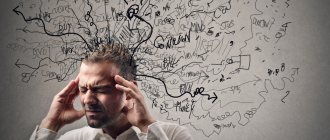A creative personality is the definition of an individual with a non-standard vision of the world, a unique approach to solving problems. The characteristics of creativity are contradictory - on the one hand, these are open, noble people, on the other, selfish, suspicious individuals. Communicating with them is an art that can bring both pleasure and leave a bitter taste.
Creativity in work and life
Creative people - what are they like?
The psychology of creativity is a huge basis for reflection, analysis and study of an individual with this line of thinking. These are interesting people with a rich inner world, a very unusual view of what is happening around them. They often have a good career, making progress in it. They have a large social circle. But they also have negative characteristics.
Note! Social research shows that creative people are more likely to have negative qualities, in contrast to the average individual.
Definition and characteristics of a creative person
In psychology, the concept of creativity is a type of thinking characteristic of people who have a penchant for a creative approach to solving problems. This is a creative direction, the main task of which is to search for completely new paths to the goal, which often leads to the emergence of unique ideas and discoveries.
A synonym for creativity is giftedness, but this is not always a good quality, since such people know their worth and often inflate it in the process of communicating with others. Statistics show that most often these are impudent people with virtually no modesty. Thanks to their rich imagination, creative people often and colorfully lie, since they themselves are not the most gullible representatives of society.
Main differences from non-creative people
People prone to creative thinking have their own culture, atmosphere, and methods of communication. They stand out from the crowd in many ways: from their appearance to their behavior. It is noteworthy that such people always remain children at heart. Although this does not make them irresponsible and indecisive, on the contrary, they have a lot to learn. This is their specialty.
Meeting creative people will never be a chore. No matter how the interlocutor imagines his creative friend, the other will always find something to surprise. In communication, such people more often listen to the voice of the heart than the mind.
Creativity and personality
Chapter from the book “Conditions of Creative Labor” by Alexander Mateiko, translated from Polish by D. I. Iordansky.
The essence of creativity, its levels, stages, prerequisites and patterns
The starting point of all creativity is the ease of forming unexpected associations; This, by the way, is where creative imagination manifests itself. The essence of the creative process lies in the reorganization of existing experience and the formation of new combinations based on it. Creativity leads to the creation of something new, since it is the antithesis of a template, stereotypical activity and does not repeat what is already known. And from here, as the famous Polish scientist T. Kotarbinsky emphasizes, it follows that a true creator is the one who, through his actions, achieves something new and valuable, and the value of what is achieved can be determined precisely by its novelty.
It is permissible to talk about the lowest and highest levels of creativity. The first is to use existing knowledge - to expand the scope of its application. This was the case, for example, with the invention of printing: the previously known method of reproducing drawings was used to reproduce texts. Creativity of the “highest level” is associated with the creation of some completely new concept, which, to a greater or lesser extent, revolutionizes science. An example of such creativity is Einstein's creation of the theory of relativity.
There is a point of view that the creative process can be divided into four main stages. At the first stage, the individual identifies a problem and gets used to it. At the second stage, he forces himself to abandon the first seemingly “evident” path to a solution in order to search for some other paths. The third stage is free speculative reasoning. Finally, in the fourth stage, a solution crystallizes.
This division of the creative process made it possible to develop a special strategy for finding solutions to certain specific problems. A discovery or invention, whether in mathematics or any other field of science or technology, results from the right combination of inputs. However, at first, what you are looking for is “lost” among a huge number of other possible combinations, most of which are meaningless and only a very small part may be fruitful. It is in the analysis of this last part, and not in the construction of useless combinations, that creativity lies. Discovery of something new involves recognition and choice. In this regard, it should be noted that we do not share the fairly widespread point of view, according to which consciousness is considered subordinate to the subconscious. Without denying the role of the latter, we believe that the former, to a greater or lesser extent, determines the general direction in which the latter functions.
Creativity is characteristic of minds that are able to think independently, without connecting the assessment of this or that information with the authority of its source. People who feel the need to constantly rely on recognized authorities are not capable of creativity. It is sometimes argued that someone who is unable to reconsider a point of view that he himself has developed and has become habitual, whose need for balance and stability decisively prevails over an interest in “dissent,” does not possess one of the elementary prerequisites for creativity. Among other similar prerequisites for it, the ability to see broad connections between various elements, to recognize the special meaning and value of a particular element not only for the present, but also for the distant future, and, finally, the ability to synthesize is often cited. In this regard, the consciousness of their “special mission”, characteristic of many creators, is especially emphasized, which allows them to concentrate psychic energy, thanks to which such people manage to overcome enormous difficulties that, as a rule, arise on the path to something new.
We can name the following patterns that characterize the creative process:
1. New solutions rarely appear as a result of conscious gradual approach to them. More often they come suddenly and unexpectedly after a period of futile efforts.
2. The solution to a complex problem usually goes from general reasoning to more and more specific ones. First, a number of possible alternatives are considered, after which one or more functional solutions are selected, which are then given a more specific form.
3. It is difficult to find a solution when the problem requires considering something well known in a completely new aspect that has not yet been accepted. The usual approach to a problem blocks the way to other approaches that differ from the accepted norm and, in this case, are necessary. An established view of a traditional object increases the likelihood of “overlooking” its possible use in a new way.
4. Sometimes firmly rooted decisions reached in one specific situation make it difficult, or even completely exclude, new decisions that meet the requirements of another situation.
5. General decisions and principles of behavior, the effectiveness of which has been well tested, can become a hindrance over time if they are inadequate to new situations that are only reminiscent of the previous ones (in which they were successfully used), but essentially different. Thus, skills associated with a certain way of thinking, evaluation system and behavior sometimes turn out to be so omnipotent that they impose conclusions that completely do not coincide with the course of reasoning. Sometimes the correct solution to a problem is delayed or becomes impossible as a result of the fact that a person unconsciously accepts an erroneous premise about an allegedly existing internal limitation of the scope of possible solutions. To the same extent, solutions can appear as if by themselves based on observations.
It is not easy to decide on a creative act, since it requires a break with the usual patterns of thinking. Most creative achievements in a particular field, as a rule, belong to only a small part of the people involved in it. For example, research in such diverse fields as music, geology, chemistry, gerontology has shown that in each of them about half of the achievements belong to a tenth of the relevant specialists. Typically, within each occupational group, the bottom 50% create less than the top 10%.
Creative Personality Traits
There are known more or less successful attempts at scientifically based determination of personality traits that accompany creativity. It has been established that creativity is greatly influenced by the ability to notice and formulate alternatives, show imagination, question seemingly obvious truths, the ability to pose questions, and avoid superficial formulations. Creators are characterized by great excitement, active interest in the problem being studied, exceptional perseverance, willingness to fight doubts, and an independent introverted position that encourages a person to stand his ground. Research tasks require a skillful combination of sobriety and courage. Hence, the willingness to take fairly accurately calculated risks is one of the essential features that guarantee creative success.
“Maturing” to creativity contains elements that can, although need not necessarily, be in opposition to each other. In order to freely operate with these elements and create new combinations of them, one must delve deeply into this area and become fused with it. At the same time, however, the very essence of creativity implies the need to somehow break away from reality and move some distance away in order to see the future. Willy-nilly, the creator finds himself in a certain isolation, and he must find enough strength and courage in himself to confront his own environment, to break with its traditions.
People with creative inclinations sometimes find themselves in conflict situations from childhood. A child who somehow stands out from his school friends arouses their hostility. His questions sometimes baffle parents. A creative attitude to work can cause dissatisfaction with less capable colleagues - bosses and colleagues. Originality, expressed in the courage to have your own opinion and take a fresh look at familiar things, is not naturally liked by everyone. She causes anxiety and does not find understanding. However, on the other hand, the willingness to take risks, which is associated with originality, to one degree or another impresses others.
It should be emphasized that grades received in higher educational institutions, especially in the first years, are a very unreliable indicator of the inclinations for creative scientific work. A study of several hundred research workers at one large American research center found no connection between the grades they received in higher education and their research success. From this it was concluded that when selecting scientific personnel, one should not be guided by the grades on the candidate’s report card.
The individual expects the society around him to satisfy basic material needs, security and the realization of the values he recognizes. He wants to feel his importance and establish himself in space and time, he wants to be connected with others, he wants, finally, to develop, to serve something, to influence decisions regarding the satisfaction of his personal needs. It is typical that among creative individuals these expectations are more strongly expressed, and sometimes clearly exaggerated. In any case, the very creative attitude towards the surrounding reality presupposes a corresponding increase in expectations. Hence the peculiar “troubles” with creative individuals who have high demands.
As one of the publicists correctly noted, many “news pioneers” (inventors, innovators, etc.) have poor adaptability to the environment; it is even possible that there is some kind of pattern in this: people “predisposed” to creativity usually deviate from the “average” norm of behavior. They have difficult, often “twisted” characters, so it is not easy for them to successfully resist those “well-adapted” people who, in their own interests, in order to maintain the status quo, may not allow the implementation of the new. Many examples can be given where inventions and improvements go to waste only because the innovators themselves are not able to overcome their inertia, and the relevant bodies and institutions, seemingly vitally interested in using the new, do not meet them halfway.
Highly creative individuals tend to show a marked interest in complex and new problems. They are much more attracted to situations that require original solutions than those that allow them to act in the usual way. They enjoy introducing their own order, synthetically, and approaching a particular task in a new way.
Thus, in his “creativity test” J.P. Guilford included testing the following intellectual qualities: fluency and flexibility of thinking, originality, the ability to approach reality in a problematic way and change formulations, and the ability to complete the solution of a given problem.
There are known attempts to typify creative personalities based on biographical data (rapid development in childhood, academic success, etc.). These methods may be more or less useful to managers of organizations that provide work to people in creative professions in order to improve their selection.
Research from the Institute for Personality Research and Assessment at the University of California, Berkeley, which involved extensive use of problem-solving experiments, sheds light on a number of questions regarding the traits of creative individuals. About 600 outstanding writers, architects, mathematicians, physicists, and representatives of technical sciences were studied. Appropriate tests were used to determine the extent to which creative traits were present in the individuals studied. Then a comparison was made between two selected groups of subjects - relatively more creative and relatively less creative. This comparison showed what other qualities these two groups differ from each other. It turned out that creative individuals are distinguished by great mental abilities, a desire to experiment and accumulate new experience, freedom from internal self-restraints, aesthetic impressionability, flexibility and independence of thinking and action, high creative energy, the ability to concentrate their creative efforts, and the desire to solve increasingly difficult problems. .
Mental abilities manifest themselves differently in different areas. For example, architects are able to freely handle space, and writers - with words.
A high level of mental ability is necessary for creativity in some areas (for example, nuclear physics) and not at all necessary in others (for example, graphics). Among people who are not at all creative, you can find many who have outstanding mental abilities. The connection between intelligence and creativity is far from simple. It is true that where a subject requires great mental ability to master its complex fundamentals, as in mathematics or physics, there is a correlation between the degree of mental ability and the originality shown in solving problems, but it is not at all great. Among painters, sculptors and graphic artists, the correlation between the quality of work and mental abilities is zero or even negative. However, it should be noted that the very fact of being called to this kind of activity presupposes, as a rule, a high level of mental abilities.
Preparing for work in a particular specialty, studying in higher educational institutions - depending on its nature - favors or hinders creativity. It can promote independence, but it can also suppress it. There is an opinion that the training of scientific and technical workers who will perform independent creative work should be separated from the training of engineers who will have to solve predetermined technological and operational problems, manage the usual production process and improve it on the basis of well-known principles. They draw attention to the fact that future creators of new technology receive too little general theoretical training in technical universities, they are overloaded with descriptive materials, are not taught to work independently, they know foreign languages poorly, pass too many exams, and do not acquire skills in working with literature by studying mainly based on incomplete notes, and often those of others, they do not think about problems, because their solution is given to them in a ready-made form, they are taught unsystematically, mainly during exam sessions. As a result, students poorly and incompletely master the educational material and they do not develop independence either in work or in thinking. The training of scientific workers, in contrast to “professional” training, should be based primarily on a system of seminars and laboratory classes.
An analysis of the results of a questionnaire survey conducted by M. Yablonskaya shows that the choice of a scientific specialty is more often influenced by the university environment than by other factors (family, acquaintances, school, material conditions). The survey was conducted in 1946-1948, 88 people were interviewed, including 20 with higher academic degrees, 47 with other academic degrees and 21 students preparing themselves for research work. M. Yablonskaya cites the following motives that guided the people she interviewed when choosing a scientific specialty: a) the desire for a stable position; b) the desire to “become one of the people”, to feel one’s own strength; c) the desire to do something very useful for society; d) the desire for knowledge...
It depends on the atmosphere prevailing in the university whether the desire for knowledge, which contributes to the formation of the most valuable possible type of scientist - the discoverer of truth, will prevail among the motives that encourage a young person to choose a scientific career. It is this type of scientist who is of the greatest value, since the achievements of such scientists lead to the formulation of new theoretical problems. However, people who lovingly engage in systematizing what has already been discovered by science, who willingly collaborate with others and thereby contribute to the multiplication of common achievements, and who are actively involved in the struggle for new scientific values also have certain advantages.
Studies conducted in various research centers show that career guidance undoubtedly benefits scientific productivity and creativity. Thus, in one large American government laboratory, research revealed a positive correlation between career orientation, productivity and creativity, and a complete lack of correlation between institutional orientation and performance of official duties. In this case, we are talking about orientation towards various reference groups. In the first case (professional guidance), the main reference group for a given person is his own professional environment. This refers to a profession that is socially clearly identified, highly organized, has privileges and the right to accept sanctions, and enjoys prestige; This is the only profession we will have in mind here. In the second case (institutional orientation), the main reference group for a given person is the organization that provides him with work. Institutional orientation is especially typical for employees of lower categories, whose specialties have a relatively low degree of professionalization; these employees are associated primarily with the organization that provides them with work.
A survey of a group of American physiologists also showed a clear positive correlation between professional orientation and productivity in scientific work. The answers obtained from interviews with 250 scientists and engineers showed that scientists value scientific and technological achievements more than engineers involved in introducing these achievements into practice.
So, serious scientific achievements clearly coincide with the professional reference group. This connection, however, is much more complex than it seems at first glance. The fact is that highly valued scientists often maintain intense contacts with colleagues whose reference group is different from their own. They need connections with people who are not competitive for them, with whom they do not compare themselves, but who give them a kind of social support. There is a dual position here - personal connections with people who are oriented towards another reference group, and at the same time identifying oneself as a scientist with people who enjoy the greatest scientific authority in this circle.
Is the ability and inclination to creativity related to age and to what extent?
The famous Polish physicist L. Infeld, based on the experience of his field of science, argues that a scientist at the age of 40 usually already reaches the pinnacle of his creativity, after which he can slowly walk along a downward path for another 20-30 years. But his imagination is gradually being emasculated, although he has an excellent command of the methods of scientific work. At the age of 40-50 years (possibly up to 55 years), such a scientist can become an excellent head of a department or institute. He teaches others, promotes young people, does not ascribe himself as a co-author to their works (for he himself already has an established reputation), thinks about finding a successor better than himself, and in 70 years, or maybe a little earlier willingly leaves the pulpit.
Studies of the activities of outstanding people in the fields of chemistry, mathematics, philosophy, literature, art, and pedagogy have shown that they usually reached their highest peak before the age of 45, and in some areas even before the age of 30. At the same time, outstanding public figures, as a rule, reached its apogee after 50 years. The fact is that in the latter case, the accumulation and “digestion” of existing knowledge is more important than the acquisition of new ones. Conditions conducive to creativity and the manifestation of originality appear in a person’s life, as a rule, earlier than the ability to achieve a leading position and recognition in society. A person inevitably has to wait for recognition until the public environment considers him an outstanding personality.
However, the thesis about the close relationship between age and creativity finds its opponents, who argue that simply too much attention is paid to what a person created in young and middle age, and his contribution in later years, which cannot be neglected, is underestimated.
Anti-conformism of a creative personality
For a creative person, sometimes more important than high mental abilities is the ability to maintain independence in the presence of internal and external pressures. Suppression of independence and restraint have a negative impact on creativity: they do not allow a person to take advantage of the rich deposits of his own experience.
Creative individuals are less likely than others to be guided by schemes [a certain schematism, naturally, is necessary, and in this sense, exercises and even drills are valuable. The development of automaticity frees you from the need to search for new ways of behavior in repetitive situations, allows you to immediately, quickly and accurately respond to certain aspects of the environment, and concentrate mental efforts on more complex issues. At the same time, automatism is fraught with known dangers. When a person acts in accordance with acquired skills in an environment that requires an unconventional approach, then these skills, turning into a Procrustean bed into which a specific situation has to be squeezed, themselves begin to control the person] and limit themselves to some rigid framework and are less likely than others to take into account conventions ; they do not idealize their childhood and their past, and are able to recognize their own shortcomings. They think relatively little about what opinions others will have about them. The attention of creative individuals is concentrated on the processes of cognition and on their own inner world. Anti-conformity allows them to act flexibly, quickly switch to new reference systems, and see an already familiar object from a completely new side. They do not attach importance to details, concentrating their attention on essential issues that have one or another clear general aspect. Theoretical and aesthetic values carry more for them than any other.
Creative individuals exhibit greater self-reliance and independence; they are better able to tolerate a state of internal anxiety, which for them, more often than for others, becomes a stimulus to action. The creative position is opposed to the conformist orientation. The latter is caused by the loneliness of the individual in a group that puts pressure on him; the objective difficulty of developing one’s own opinion (the more complex certain problems for a given person, the greater his conformity); the belief that group members are competent; specific benefits obtained through conformity; inability to find a positive way out of a stressful situation [From English. stress - tension. A state of strong emotional stress caused by external factors or influences or artificially created during an experiment - Approx. transl.]; consciousness of one's own inferiority and unsuitability; inability to openly express one’s emotions and, finally, insufficient flexibility of the mind in the process of cognition.
The pressure of the group, the desire to subordinate the individual to its norms and expectations, on the one hand, as well as the inability of the individual to cope with himself, on the other, undoubtedly prevent the crystallization of a creative position. However, everything depends on the strength of these factors. After all, internal conflicts represent a very strong creative stimulus, if they are not so great as to simply paralyze a given individual, depriving him of the opportunity to take any constructive action. Group pressure also directly aids creativity in many cases.
People of exceptional creative ability are more likely than others to interpret power as something conditional rather than absolute. They are less inclined to divide everything into white and black. They show independence of judgment and are devoid of inertia both intellectually and socially. They are characterized by a love of entertainment, which gives vent to their “irrational” impulses. They love humor more than others and really have a great sense of humor. In general, they are freer than others and subject to less self-control.
Attitude to life of a creative person
Creative abilities - what is it in psychology
It is impossible to unambiguously describe the attitude to life of a creative figure. He is dreamy by nature. He sees inspiration around him, new ideas, aspirations, and discoveries arise in him. At the same time, these people rarely recognize their creations; usually the work performed does not please such a person, and at other times even leads to depression.
Failure as an impetus for action
Note! For all their outward positivity, it is creative people who are more prone to various types of depression.
However, it often happens that it is the negative phenomena in the life of the creator that push him to intensive work, into which he plunges headlong.
Courage and strength
Creators often have to take risks when bringing their inventions to life. A certain amount of courage is needed here, because the creation may not find a response and may be criticized. It takes a lot of internal strength to resist such phenomena.
Often, endless experiments and experiments, on which a lot of effort and money have been spent, end in failure. Creators are not afraid to make mistakes . Accepting failure and starting from scratch requires strong will, determination, optimism and perseverance.
Stable creative thinking distinguishes all creative individuals. At the same time, inspiration, ideas that come out of nowhere, cannot be controlled. Just as they come unexpectedly, they disappear just as suddenly, plunging the creator into despondency.
You will find out what other signs of a creative personality are by watching the video:
How to communicate with a creative person
Human character traits - what they are, their description and characteristics
Having met a creative person, it is worth remembering that such a person tends to perceive life positions differently and stubbornly adhere to his reality, beliefs and views. In the art of communicating with her, it is recommended to adhere to the “Three Ps” rule:
- Adjust. Society has still not decided on the truth of the phrase “people don’t change,” but we can say with absolute confidence: a representative of creativity cannot be changed. If someone wants to continue communicating with such a person, he can only adapt to his habits and character;
- Understand. Considering the unconventional thinking of such people, you should not try to convince them of anything; it’s easier to try to understand why they think this way and not otherwise;
- Forgive. In general, these are kind, unselfish people, but they can be harsh or too passionate about their occupation. If they expressed themselves incorrectly or forgot something important, you shouldn’t hold a grudge against them.
Problems in communicating with a spiritual person
A creative character is independent in everything, he is used to relying on himself. When communicating with such an individual, you should be prepared for the fact that he may be offended or offend his interlocutor with common interests. Considering how much such people like to dream, it happens that the creator has already “experienced” some dialogue in his head that did not happen in reality, and behaves appropriately. Such moments are difficult to catch, understand, explain, and getting answers from such a person can be difficult.
Intrinsic motivation
Creative people cannot help but create . This is probably their main distinguishing feature. Creativity is their state of mind, their way of life. All other things fade into the background when inspiration .
Passionate passion for work helps create masterpieces that the whole world admires
Creators are driven more by internal motivation rather than material reward. Money is a nice bonus. Typically, agents promote geniuses.
Work for a creative person
“Toxic” people - who are they in psychology?
Work for a creative person is not only drawing, photography, creating music, etc. This line of thinking is not limited to the stereotypical profession of an artist; on the contrary, the best scientists come from them. The ability to think more broadly allows you to complete scientific projects faster. Creative creativity helps to formulate unique theories and boldly test them in practice. Even when faced with failure, an individual will strive to solve the problem even more stubbornly.
A creative mind is also important in science
Search for new experiences
Creative individuals strive for new experiences . They love to experience them, they specifically look for them. From them creators draw material for their creations. Curiosity, the search for new sensations, emotionality, sensitivity, and developed imagination are the engine of their creative activity.
Many people use meditation to be more productive. It optimizes emotions, relieves anxiety, stimulates mental clarity, which allows you to tune in to the creative process.
Meditation
Personal space of a creative person
Personal space is a controversial issue in the understanding of creative people. Much depends on the character of the individual.
Note! Society often dislikes creative people for violating their personal space.
Representatives of the creative world are often open and positive, at least outwardly. They are willing to make contact; if they notice something interesting about their interlocutor, they are ready to touch him with their hands up and down. They often treat their personal space calmly and tolerantly. The only period when it is worth leaving the creator alone is the peak of his active activity.
The desire to dream and try to realize it in your life
The desire to constantly dream and try to realize it in your life seems completely absurd and even funny to many people. After all, most people perceive the dream of a creative person as a certain fantasy that is completely impossible to bring to life. Therefore, it becomes difficult to understand a creative person, and besides, for most people, dreamers cause some specific concerns.
Of course, creative people do not always understand everything, because not every ordinary person is able to see what they see.
Share
Development of personal creative potential
It is believed that everyone has a penchant for creativity, for some it manifests itself in early childhood, for others it remains deep in the mind. Creative thinking can be trained, although it is a rather difficult process. The development of creative potential should begin from childhood, showing children such an interesting world. As for an adult, he needs motivation and personal desire, otherwise the effectiveness of such training will be zero.
The process of developing this line of thinking is usually focused on elements such as:
- Theoretical preparation of the individual, familiarizing him with the methods used in increasing abilities. Simply put, a person is introduced to the basic concepts of this issue, the ability to apply theory in practice, and also ensures the development of individual and group thinking skills in this direction;
- Training the ability for further regular self-development. This moment includes observation of different representatives of this type of thinking, analysis of their behavior, intellectual activity;
- Formation and consolidation of the individual’s potential, including the study and practice of new ways of communication using the acquired knowledge. It is necessary to constantly look at situations and phenomena from different sides: the usual and creative point of view.
Thus, the individual will not only learn what creativity is, what motivates people with such thinking, but will also try on the role of bold common sense, the ability to look beyond the boundaries of the usual.
Creative thinking can be learned
Unconventional thinking, a creative approach to a situation, mysterious behavior - all these are descriptions of a creative personality. Communicating with such a person and being him are completely different phenomena. Such people differ from society in behavior and appearance, and at the same time have a special worldview and their own way of thinking. Creative thinking is not limited to the ability to draw, sculpt, or fantasize. This is an important element in scientific activity, helping humanity to study and make new discoveries.
Observation
It is often said about creative individuals that they are in some kind of their own world, “on their own wavelength . Actually this is not true. They really may not notice what they eat, what they sit on, what they wear. It was said about one chemistry professor, a contemporary of Marshak, that he mechanically took off his galoshes when entering a tram. He even said that the poet wrote Scattered from Basseynaya Street based on him.
Such observation usually manifests itself in one area. If this is a writer, then he notices the smallest details in people’s behavior, their speech, and relationships. If this is a sculptor, then he sees people’s gestures and poses in his own way.
Their abilities allow them to see opportunities where others do not.
When creators are asked how you did it, they often can't explain it. Creativity is a special process that synthesizes several seemingly unrelated things.
Creative person
Creative thinking tests
Of course, once you've realized the benefits of being a creative person, you'll want to know how creative you are. Therefore, below I give you a list of tests that will help diagnose your level of creativity.
- "Torrens test". This is one of the best tests that measure creative thinking. You need to answer the questions without thinking too much about the answers, then you will get truthful results. This is a verbal test, but this technique also has a figurative part, where you should complete the lines at your discretion. This technique is carried out by a specialist.
- “Creativity Test.” By answering 20 questions, you will understand whether you can think creatively and creatively. The test is not scientific, but it can help you understand yourself.
- “Diagnostics of creativity E. Tunik.” You should answer 50 questions to help you understand yourself. After taking the test, your results will be divided into 4 subcategories: risk taking, imagination, curiosity, complexity.
- “Test of Divergent (Creative) Thinking” by Williams. This is a very revealing test by which you can determine the level of creativity of both a child and an adult. According to the instructions, you need to complete 12 images, and the results are assessed according to several criteria. It is better to take this test with a specialist.
The dark side of creative people
According to sociologists, there are some characteristics that are characteristic of many people whose lives are connected with art or craft.
Creative people have well-developed figurative-spatial thinking and imagination. It is easy for them to get used to different roles; they love to try on all sorts of images. This all sounds beautiful, but try to look at the essence to understand: creative people know how and love to lie.
Not all of them are pathological liars, but if you have to hide the truth, believe me, a person with creative thinking will do a great job. But you shouldn’t deceive them: having excellent intuition, they subtly sense any insincerity.
According to family psychologists, such people are more likely than others to commit adultery. Many of them do not consider adultery as a grave sin; for them, it is rather a way to assert themselves, play another role, be convinced of their magnificence and expand the circle of those who are ready to applaud them.
Of course, you can’t cut everyone with the same brush. We are talking only about statistics, and not about the fact that every individual passionate about creativity is capable of treason. If such a person receives enough support from his partner, if they believe in his strengths and abilities, he is unlikely to go looking for adventure on the side.










